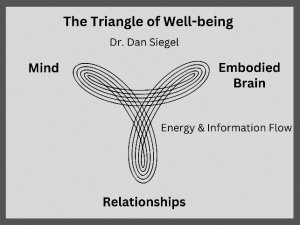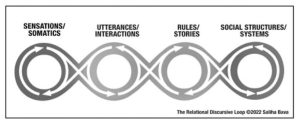Chapter 11: A Relational Approach to Settlement Work Relational Spaces and Practices for Anti-Oppression and Well-Being
Interpersonal Neurobiology and Relationships
This section introduces six topics from interpersonal neurobiology, or IPNB. IPNB is a broad framework developed by Dr. Dan Siegel that draws on a wide range of disciplines to explore what it means to be human. It seeks to create an understanding of the interconnections among the body and its brain, the mind, and our relationships with ourselves, others, and the planet. IPNB is another way to understand our relatedness and a relational approach by understanding how relationships and the brain interact to shape who we are (Siegel, 2022). The purpose of this section is to introduce six topics and various practices:
- Triangle of Well-Being
- The Nervous System
- Window of Tolerance
- FACES
- Rupture and Repair
- The Science of Social Justice: The Collective Nervous System
The initial section lays the groundwork for approaching social justice and well-being from a relational perspective, incorporating insights from the work of Dr. Dan Siegel, the practical implications of polyvagal theory (Porges, 2011), and the concept of rupture and repair (Tronick, 2017). The following segment delves into the Triangle of Well-Being (Siegel, 2012), examining the intricate connections between the mind, the embodied brain (which encompasses the brain and the nervous system), and human relationships. Moving forward, we explore an additional valuable framework for comprehending how relationships can enhance resilience in times of stress by combining the window of tolerance with polyvagal theory. Finally, we examine the importance of actively addressing and resolving emotional disconnections (ruptures) to facilitate healthy growth and development within nurturing relationships.
The Triangle of Well-Being
According to Siegel, three elements work together to help each person create a better quality of life: the mind, the embodied brain, and relationships. He calls this the Triangle of Well-being (Figure 2).
The Triangle of Well-Being is a metaphorical representation comprising three integral components: the mind, the embodied brain, and relationships and how they are involved in well-being. It symbolizes the interconnectedness of these facets, depicting each as a singular reality with interdependent aspects. This triangle illustrates the continuous flow of energy and information, which evolves. Relationships involve sharing this flow, while the embodied brain denotes the extended nervous system distributed throughout the body, serving as the physical conduit for this flow. On the other hand, the mind emerges from the dynamic system of energy and information exchange within individuals and among them. A crucial aspect of the mind is its ability to self-regulate, controlling the process from which it originates.

Fundamentally, the mind can control and shape the brain, a phenomenon termed neuroplasticity. Our internal processes, including our thoughts, behaviours, and how we engage with others, can result in significant alterations in the brain, whether positive or negative. The downside occurs when harmful emotions, thoughts, and behaviours take hold, but the upside emerges when we gain new insights, regulate our emotions, and foster healthy and rewarding relationships. Building positive connections with others through experiences can stimulate brain growth. Siegel (2012/2022) views the mind, the embodied brain, and relationships as three different dimensions of one reality that form an interconnected Triangle of Well-Being.
The mind is “an emergent, self-organizing, embodied and relational process that regulates the flow of energy and information” (Siegel, 2022, p. 6). Siegel suggests that our minds grow and work better when interacting with others, and our brains change over time. He also believes that our minds help control how energy and information move inside our bodies and between us, other people, and the world around us. In simpler terms, our minds develop and help us manage things as we connect with others and experience changes in our brains. They also help us handle energy and information in our bodies and our relationships with people and the world (Siegel, 2022).
The embodied brain is complex, consisting of numerous distinct components that operate as a cohesive system, with information flowing through various specialized parts in the brain, body, and nervous system (Siegel, 2022). The purpose of the nervous system is to regulate the complex processes of the body. Integration is how the nervous system becomes coordinated and balanced. Regulation results from integration, a dynamic process of differentiation and linking. In a societal circle of relationships, this is known as unity in diversity. Supporting integration in different circles of relationships is one of the key roles of settlement practitioners.
Watch the video Daniel Siegel on the Triangle of Well-Being (Greater Good Science Center, 2010) to hear Dr. Siegel explain the Triangle of Well-Being.
In the video A Truly Connected Life | Dan Siegel | Wisdom 2.0 2017 (Wisdom 2.0 with Soren Gordhamer, 2017), Dr. Siegel explains why the relational dimension of life matters more than ever.
The Nervous System
A relational approach involves the often-overlooked nervous system. Usually, when we meet another person, we use our various senses to communicate verbally and non-verbally. There is also another way we communicate what is happening inside our bodies to other people based on three principles:
- Autonomic hierarchy: The autonomic nervous system is organized around three building blocks—the ventral vagal system of connection, the sympathetic system of action, and the dorsal vagal system of shutdown—that work in a specific order and come with preset pathways.
- Neuroception: This built-in surveillance system watches for signs of safety and sends warnings about possible danger ahead.
- Co-regulation: Moments of safely connecting to others is necessary for well-being.
(Dana, 2021, p. 16)
The video Trauma and the nervous system: a polyvagal perspective (Polyvagal Institute, 2021) explains how our autonomic nervous system works and why trauma and chronic stress can result in a dysregulated nervous system. A relational approach empowers settlement practitioners to check in on their nervous system and support clients.
Connection or Protection?
“We label people in a lot of ways. We say they don’t care, they’re not trying, they don’t want to change, or they’re lazy, irresponsible, always angry, or unreliable. What if instead of using these labels we thought about people as being dysregulated? Behaviour makes sense when we look at it through the autonomic state. When someone is pulled into the mobilizing energy of sympathetic fight and flight or trapped in dorsal shutdown, their biology doesn’t support them coming into connection and co-regulating or using healthy strategies of self-regulation.”
– Deb Dana, 2021, p. 93
Window of Tolerance and Emotional Regulation

Building on the previous video, here is another useful way of understanding how to recognize when your or a client’s nervous system is in a state of calm or dysregulation. The Window of Tolerance, originally described by Dr. Dan Siegel, can be valuable for settlement practitioners working with immigrants and refugees, considering the inherently stressful nature of settlement, especially for those who have experienced trauma. It is a crucial resource for practitioners to offer trauma-informed and relationally centred care, fostering safe and supportive environments for their clients. Recognizing signs of hyperarousal or hypoarousal in clients enables practitioners to respond with sensitivity and avoid re-traumatization. This emotional attunement and support are foundational aspects of a relational approach, helping clients regulate their emotions, enhancing resilience, and equipping them to navigate settlement challenges while nurturing a sense of agency and trust in the practitioner-client relationship.
Extending the application of the Window of Tolerance to a collective level allows practitioners to assess the well-being of expanding circles of care and concern within communities. Settlement practitioners can also apply this concept to their self-care, recognizing moments of potential vicarious trauma or burnout caused by the emotional demands of their work. By taking necessary steps to seek support and maintain their Window of Tolerance, practitioners can effectively self-regulate when conditions push them towards hyper- or hypo-arousal. In this way, a relational approach creates conditions within teams and communities that promote mutual care, ensuring that practitioners can continue to provide relationally centred care to their clients while contributing to the community’s collective well-being.
Watch the video The Window of Tolerance (Golddigger Trust Wellbeing Team, 2021) about the Window of Tolerance and how it is helpful in understanding how we react.
FACES
From an interpersonal neurobiology (IPNB) perspective, relationships are the most adaptive and flexible when they are integrated. Dr. Dan Siegel offers the FACES flow—a view that well-being comes from structural and functional integration:
F = Flexibility (or when not linking, inflexible)
A = Adaptive (or when not linking, maladaptive)
C = Coherent (holds together well under dynamic systems over time; or when not linking, incoherent)
E = Energized (vital; either depleted or excessively aroused when not linking)
S = Stable (equanimity; when not linking, instability or repeating negative patterns)
Structural integration refers to the interconnectedness of different regions of the brain, and functional integration refers to how these areas work together. An effective balance of differentiation and linkage arises within tolerable levels of autonomic nervous system activation. Levels outside a person’s Window of Tolerance that emerge when integration is impaired may be accompanied by a diminished capacity to function adaptively and flexibly. The FACES flow is another way that practitioners can attune to a client’s or relationship’s emotional tone.
Rupture and Repair
Psychologist Ed Tronick’s (2017) research on parent-child communication revealed that mismatches in connection, commonly referred to as “ruptures,” are a prevalent and integral element within the interactive connection-disconnection-reconnection cycle, often known as “rupture and repair.” This process is essential for fostering healthy development within nurturing relationships. Through these experiences, children understand that relationships can be complex, with occasional missed opportunities for connection, but they also learn that these ruptures can be mended. This cycle of connect-disconnect-reconnect forms the foundation for nurturing well-being and developing trust and resilience.
Interpersonal communication, conflict, and relationship management skills are important for repairing ruptures. In this section, we examine four more subtle skills: tracking, alignment, attunement, and resonance. These often-unconscious aspects of interpersonal connection are part of healthy, close relationships. Ruptures are an inevitable part of life because of distractions or misunderstandings, so repair is important in creating healthy relationships. Siegel (2022) describes the following four capacities:

1. Tracking in interpersonal communication involves focusing our attention on the signals and cues provided by another person and staying attuned to their changing emotional states in real time. By doing so, we can adapt our emotional state to match or align with another person (Siegel, 2022).
2. Alignment, a key component of affect or emotional attunement, refers to adjusting one’s emotional state to closely resemble that of the other person in a social interaction. This alignment can occur in a one-way manner, where one person aligns with the other, or it can be a mutual, bi-directional process in which both individuals adjust their emotional states to be more in sync. Tracking another person’s emotional state initiates an initial alignment that makes both individuals feel understood and “felt.”
3. Attunement encompasses alignment but goes beyond it by including an awareness of situations in which alignment may not be appropriate or beneficial. It’s not a perfect or continuous matching of emotional states, but rather a dynamic process involving various degrees of alignment and misalignment, and moments of synchrony and desynchrony. These fluctuations can eventually lead to reconnection and reunion between individuals.
4. Resonance: Overall, attunement results in mutual influence, often referred to as resonance, where each person affects and is affected by the other. For instance, emotional resonance extends beyond the immediate alignment of emotions and can have a long-term impact on the mental state of an individual—the quality of a relationship matters. Resonance is also described as the experience of synchrony between inner experience and inter-experience. This points to the way authentic relationships can make a difference.
The Relational Discursive Loop
More and more organizations across the world are institutionalizing much needed anti-racism, diversity, equity, and inclusion (ADEI) policies and systems, but employees are confronting a fundamental gap—the gap between organization-wide AEDI policies and the individual challenges we face creating diverse, equitable, inclusive relationships in our daily workplace interactions and conversations (Bava & Greene, 2023, p. 7).

The concept of the Relational Discursive Loop (Bava & Greene, 2023) originates from organizational development and AEDI work. This framework serves as a tool for making sense of our interactions and fostering awareness while addressing the complexities that arise in our everyday conversations. It offers insight into the intricacies of social relationships and consists of four key components: sensations/somatics, utterances/interactions, rules/stories, and social structures/systems (Figure 4).
In our earlier discussion, we explored the sensory and somatic aspects, particularly in the context of the nervous system. The Relational Discursive Loop also broadens our understanding of tracking, alignment, and attunement by encouraging us to expand our perception and focus on four dimensions of relating, as depicted in Figure 4. It emphasizes how these dimensions interact as a system. Since they are interconnected, practitioners can envision how changes in one dimension may impact all the other dimensions.
Listen to Bava and Greene discuss their work in the video The Relational Workplace (Remaking Manhood, 2023).
In simpler terms, their way of looking at relational intelligence helps us see how relationships and society work together to shape our social world, including our lives, relationships, and who we are as individuals (Bava & Greene, 2023, p. 31). Relational intelligence is about building and maintaining meaningful relationships in our network of connections.
Dr. Bava created the Relational Discursive Loop as one of many capacities and frames designed to help individual members of organizations grow ADEI cultures of connection using specific, trainable relational practices and grow “collective relational intelligence.”
Listen to Dr. Bava explain the Relational Discursive Loop (Bava, 2023) and read the examples in Chapter 15 of her book with Greene, The Relational Workplace: How Relational Intelligence Grows Diverse, Equitable, and Inclusive Cultures of Connection.
Image Credits (images are listed in order of appearance)
Apedaile, S. (n.d.). Triangle of well-being [Diagram]. Used with permission.
Vanasupa, L., & Barabino, G. (2021, July 28). Nerve activation states from polyvagal theory [Diagram] (p. 91). IntechOpen. https://www.intechopen.com/chapters/77711, licensed under CC BY 3.0
Old radio by 200degrees, Pixabay licence
Bava, S., & Greene, M. (2023). Relational discursive loop [Diagram] (pp. 99, 109). ThinkPlay Partners. Used with permission of Dr. Saliha Bava.

